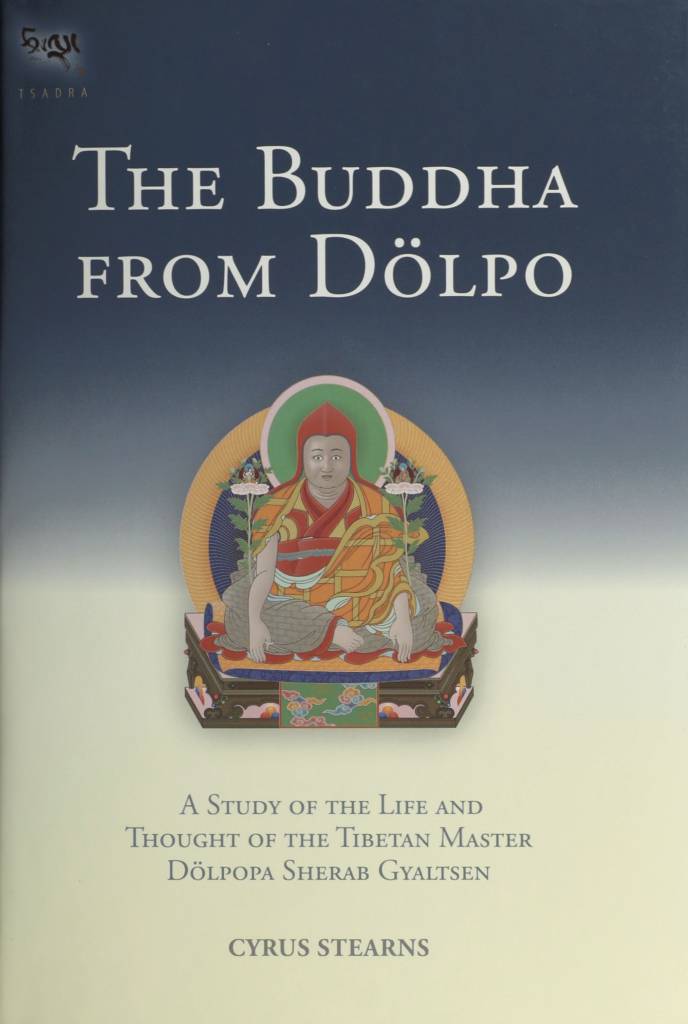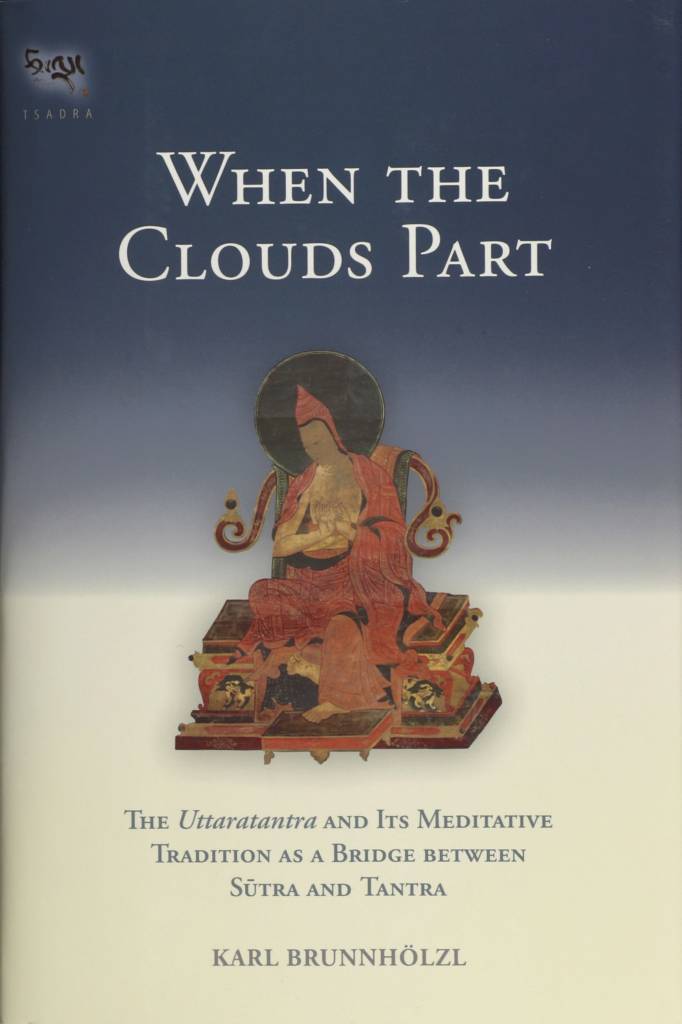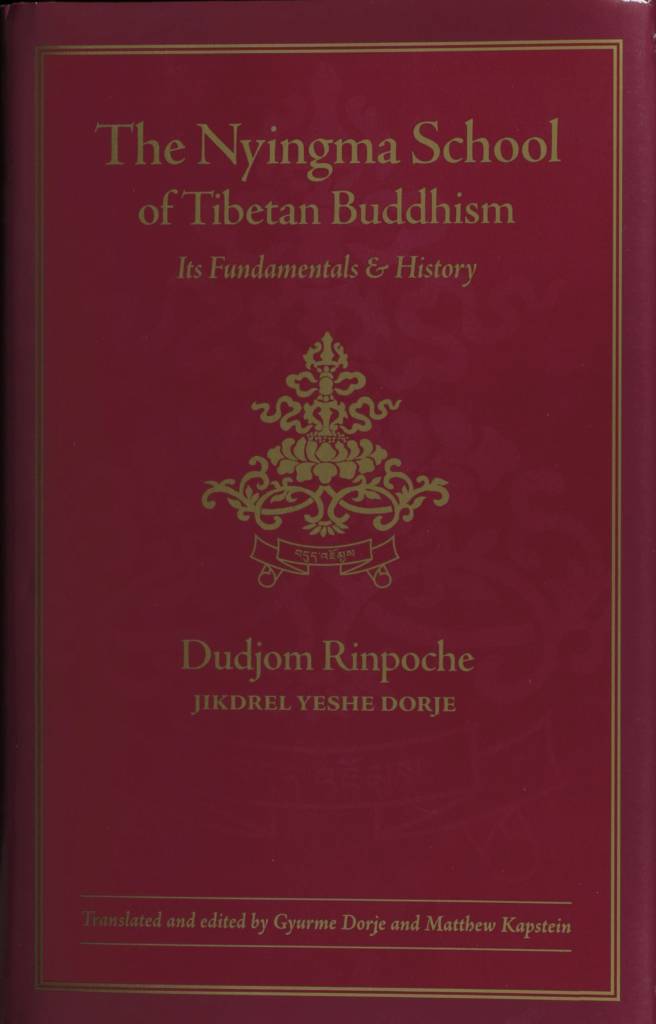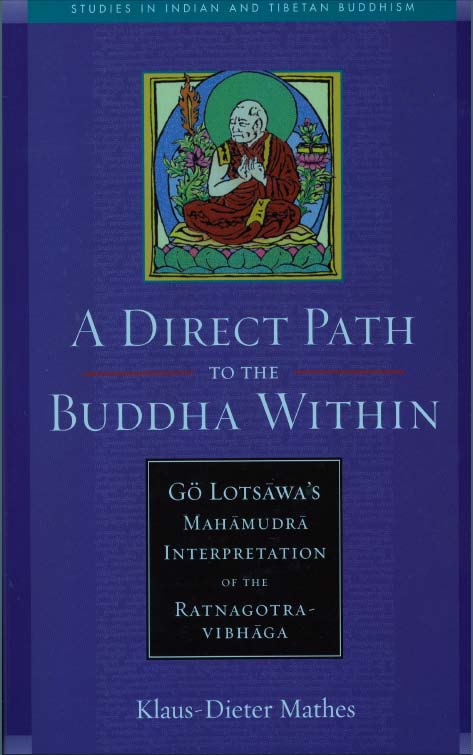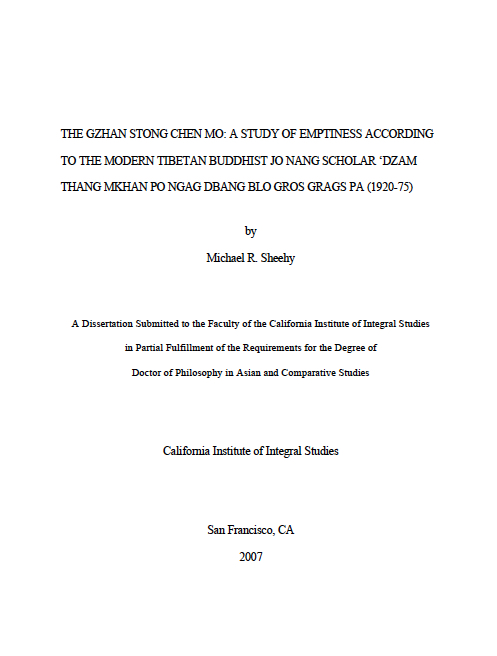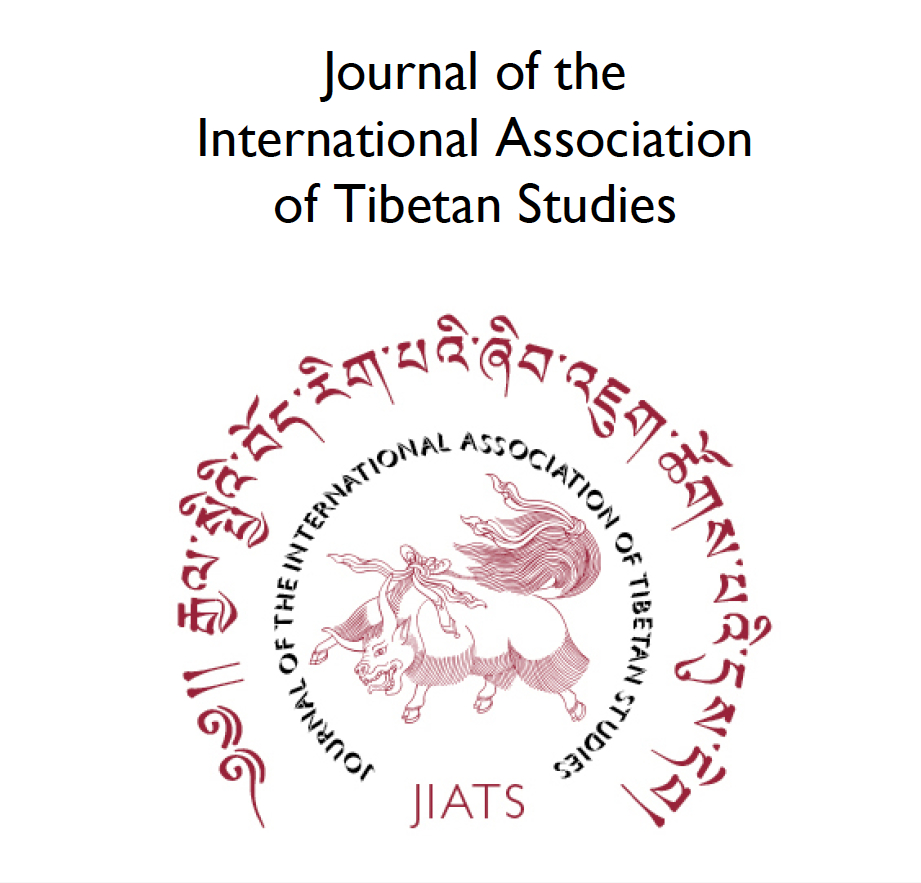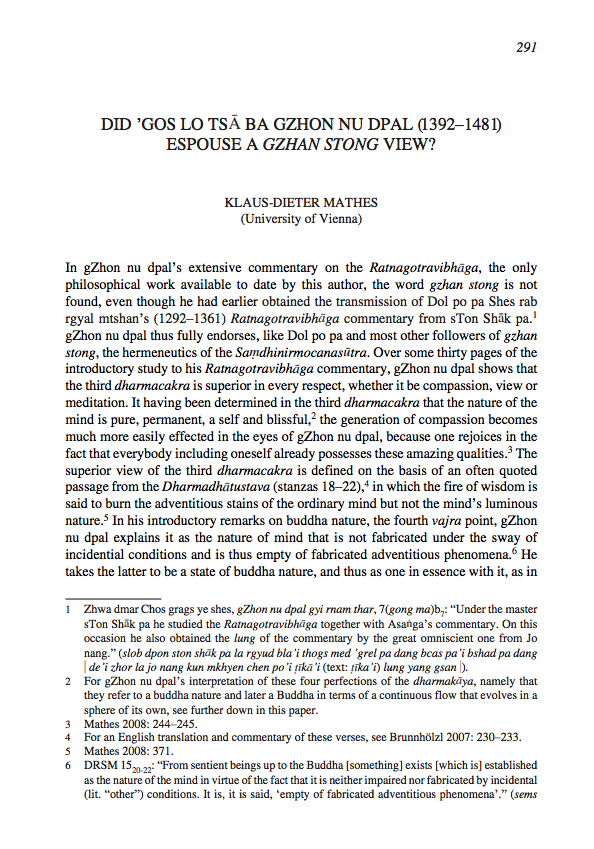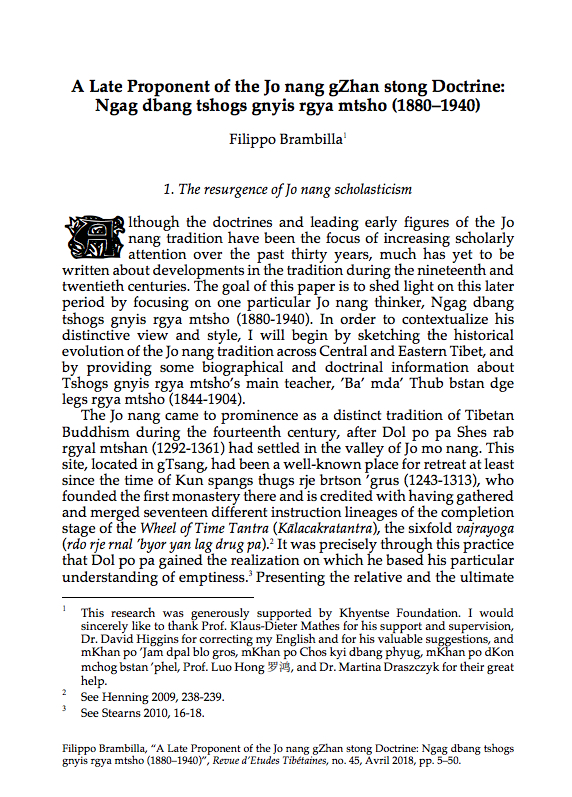Other-Emptiness and the Great Middle Way
Watch & Learn
Traditional Sources
Maitreya
Verse I.155 of the Ratnagotravibhāga Mahāyānottaratantraśāstra states:
།རྣམ་དབྱེར་བཅས་པའི་མཚན་ཉིད་ཅན།
།གློ་བུར་དག་གིས་ཁམས་སྟོང་གི།
།རྣམ་དབྱེར་མེད་པའི་མཚན་ཉིད་ཅན།
།བླ་མེད་ཆོས་ཀྱིས་སྟོང་མ་ཡིན།
The basic element is empty of what is adventitious,
Which has the characteristic of being separable.
It is not empty of the unsurpassable attributes,
Which have the characteristic of being inseparable.~ Brunnhölzl, Karl. When the Clouds Part: The Uttaratantra and Its Meditative Tradition as a Bridge between Sūtra and Tantra. Boston: Snow Lion Publications, an imprint of Shambhala Publications, 2014, p. 411.
Asaṅga
In the commentary to verse I.155, it states:
།འདིས་ཅི་བསྟན་ཞེ་ན། གང་གི་ཕྱིར་རང་བཞིན་གྱིས་ཡོངས་སུ་དག་པ་དེ་བཞིན་གཤེགས་པའི་ཁམས་འདི་ལས་བསལ་བར་བྱ་བ་ཀུན་ནས་ཉོན་མོངས་པའི་རྒྱུ་མཚན་ནི་འགའ་ཡང་མེད་ལ། གློ་བུར་བའི་དྲི་མ་དང་བྲལ་བ་ནི་འདིའི་རང་བཞིན་ཡིན་པའི་ཕྱིར་རོ། །འདི་ལ་རྣམ་པར་བྱང་བའི་རྒྱུ་མཚན་ཅན་གཞག་པར་བྱ་བ་ཡང་ཅུང་ཟད་ཀྱང་ཡོད་པ་མ་ཡིན་ཏེ། རྣམ་པར་དབྱེ་བ་མེད་པའི་ཆོས་དག་པའི་ཆོས་ཉིད་ནི་རང་བཞིན་ཡིན་པའི་ཕྱིར་རོ། །དེས་ན་དེ་བཞིན་གཤེགས་པའི་སྙིང་པོ་ནི། རྣམ་པར་དབྱེ་བ་ཡོད་པ། བྲལ་ཤེས་པ། ཉོན་མོངས་པའི་སྦུབས་ཐམས་ཅད་ཀྱིས་ནི་སྟོང་པ་ཡིན་ལ། རྣམ་པར་དབྱེ་བ་མེད་པ། བྲལ་མི་ཤེས་པ། བསམ་གྱིས་མི་ཁྱབ་པའི་སངས་རྒྱས་ཀྱི་ཆོས་གང་གཱའི་ཀླུང་གི་བྱེ་མ་ལས་འདས་པ་ནི་མི་སྟོང་ངོ་ཞེས་གསུངས་སོ། །དེ་ལྟར་ན་གང་ཞིག་གང་ན་མེད་པ་དེ་ནི་དེས་སྟོང་ངོ་ཞེས་ཡང་དག་པར་རྗེས་སུ་མཐོང་ལ། གང་ཞིག་ལྷག་པར་གྱུར་པ་དེ་ནི་དེ་ལ་རྟག་པར་ཡོད་དོ་ཞེས་ཡང་དག་པ་ཇི་ལྟ་བ་བཞིན་དུ་ཤེས་སོ། །ཚིགས་སུ་བཅད་པ་འདི་གཉིས་ཀྱིས་ནི་སྒྲོ་འདོགས་པ་དང་སྐུར་པ་འདེབས་པའི་མཐའ་དང་བྲལ་བའི་ཕྱིར། ཕྱིན་ཅི་མ་ལོག་པ་སྟོང་པ་ཉིད་ཀྱི་མཚན་ཉིད་བསྟན་ཏོ། །དེ་ལ་གང་ཞིག་སྟོང་པ་ཉིད་ཀྱི་ཚུལ་འདི་ལས་སེམས་ཕྱི་རོལ་ཏུ་རྣམ་པར་གཡེང་ཞིང་རྣམ་པར་འཕྲོ་ལ་མཉམ་པར་མི་འཇོག་ཅིང་རྩེ་གཅིག་ཏུ་མི་འགྱུར་བ་དེས་ན་དེ་དག་སྟོང་པ་ཉིད་ལས་སེམས་རྣམ་པར་གཡེངས་པ་ཞེས་བརྗོད་དོ། །དེ་ལ་དོན་དམ་པ་སྟོང་པ་ཉིད་ཀྱི་ཡེ་ཤེས་མེད་པར་ནི་རྣམ་པར་རྟོག་པ་མེད་པའི་དག་པའི་དབྱིངས་རྟོགས་ཤིང་མངོན་པར་འདུ་བྱ་བར་མི་ནུས་སོ།What is taught by this? There is no characteristic of afflicted phenomena to be removed from the basic element of the tathāgatas that is completely pure by nature because it has the nature of being the emptiness of adventitious stains. Nor is the slightest characteristic of purified phenomena to be added to it because it has the nature of inseparable pure attributes. Therefore, [the Śrīmālādevīsūtra] says:
The tathāgata heart is empty of all cocoons of afflictions that are separable [from it] and [can] be realized as being divisible [from it]. It is not empty of the inconceivable buddha attributes that are inseparable [from it], [can]not be realized as being divisible [from it], and far surpass the sand grains in the river Gaṅgā [in number].
Thus, one clearly sees that when something does not exist somewhere, the [latter] is empty of the [former]. In accordance with actual reality, one understands that what remains there exists as a real existent. These two verses elucidate the unmistaken defining characteristic of emptiness [in the case of the tathāgata heart] since it [thus] is free from the extremes of superimposition and denial.
Here, those whose minds are distracted from, and stray outside of, this principle of the meaning of emptiness, do not cultivate it in samādhi, and are not one-pointed [with regard to it] are therefore called "those whose minds are distracted from emptiness." Without being introduced to the wisdom of ultimate emptiness, one is not able to realize and directly perceive the nonconceptual basic element.
~ Brunnhölzl, Karl. When the Clouds Part: The Uttaratantra and Its Meditative Tradition as a Bridge between Sūtra and Tantra. Boston: Snow Lion Publications, an imprint of Shambhala Publications, 2014, p. 411.
Kadam
Tsen Khawoche
In a brief work entitled Instructions on the View of Other-Emptiness, which is preserved among the 108 Profound Instructions of the Jonang, Tsen Khawoche describes the three natures thusly:
དེས་ན་ཀུན་བརྟག་རང་གི་ངོ་བོས་སྟོང་པ་ཉིད་རི་བོང་གི་རྭ་ལྟ་བུ། གཞན་དབང་ཀུན་བརྟགས་ཀྱིས་སྟོང་པས་སྒྱུ་མ་ལྟ་བུ། ཡོངས་གྲུབ་ཀུན་བརྟག་གཞན་དབང་གཉིས་ཀར་གྱིས་སྟོང་པས་ནམ་མཁའ་ལྟ་བུ། ཀུན་བརྟག་གཞན་དབང་གི་ཐ་སྙད་ཀུན་རྫོབ་ཏུ་ཡོད་ཀྱི་དོན་དམ་དུ་མེད་ལ། ཆོས་ཉིད་ཡོངས་གྲུབ་ནི་དོན་དམ་དུ་ཡོད་ཀྱི། ཆོས་ཅན་ཀུན་རྫོབ་དང་ངོ་བོ་གཅིག་ཐ་དད་གང་ཡང་མ་ཡིན་པ་མཐའ་ཐམས་ཅད་དང་བྲལ་བའི་དབུ་མ་ཆེན་པོའོ།
In this way, the imaginary nature is devoid of an intrinsic essence, like a hare's horns. The relational nature is devoid of the imaginary nature, like an illusion. The perfected nature is devoid of both the imaginary nature and the relational nature, like space. Distinctions between the imaginary and the relational are relative, not absolute. The perfected actuality of phenomena is absolute. This is the Great Middle Way, free from extremes without being in any way either identical or different in essence from the phenomenal quality of relative reality.~ Btsan kha bo che. Gzhan stong lta khrid. In Zab khrid brgya dang brgyad kyi yi ge. Edited by Kun dga' grol mchog. Gdams ngag mdzod. New Delhi: Shechen Publications, 1999: Vol. 18, p. 171.
~ Translation from Tsen Kawoche. "Elucidating the Zhentong View: A Condensation of the Threefold Nature of Reality." Translated by Michael R. Sheehy. Jonang Foundation’s Digital Library, n.d.
Jonang
Dölpopa Sherab Gyaltsen
As a basic definition, Dölpopa states:
དེ་ལ་ཀུན་རྫོབ་གློ་བུར་བའི་དངོས་པོ་རྣམས་ནི་གནས་ལུགས་ལ་གཏན་ནས་མེད་པའི་ཕྱིར་རང་གི་ངོ་བོས་སྟོང་སྟེ་དེ་ནི་རང་སྟོང་ངོ་། ཀུན་རྫོབ་དེ་རྣམས་ཀྱིས་སྟོང་པའི་དོན་དམ་སྟོང་པའི་དོན་དམ་གཉུག་མ་ནི་ནམ་ལང་མེད་པ་མ་ཡིན་པའི་ཕྱིར་གཞན་སྟོང་ངོ་།
Since adventitious, relative entities do not exist at all in reality, they are empty of their own essences; they are self-empty. The innate ultimate, which is the ultimate emptiness of these relative things, is never non-existent; therefore, it is other-empty.~ Dol po pa shes rab rgyal mtshan. Dpon byang ba'i phyag tu phul ba'i chos kyi shan 'byed. In gsung 'bum shes rab rgyal mtshan ('Dzamthang ed., 1998), Vol. 6: 416.
~ Translation from Duckworth, Douglas S. "Onto-theology and Emptiness: The Nature of Buddha-Nature." Journal of the American Academy of Religion 82, no. 4, (2014): 1075.
In his Fourth Council, Dölpopa states:
།གལ་ཏེ་དོན་དམ་རིག་པ་ཡིན་ན་ནི།
།འདུས་མ་བྱས་ཀྱི་རིག་པ་ཁུར་ནས་འོང༌།
།རྟག་ཅིང་བརྟན་པའི་རིག་པའང་ཁུར་ནས་འོང༌།
།ཐེར་ཟུག་གཡུང་དྲུང་རིག་པའང་ཁུར་ནས་འོང༌།
།བདེ་གཤེགས་སྙིང་པོ་རིག་པའང་ཁུར་ནས་འོང༌།
།ཡོངས་གྲུབ་དགུ་ཡི་རིག་པའང་དེ་བཞིན་ནོ།
If the absolute is pure awareness, that entails unconditioned pure awareness.
It also entails permanent and stable pure awareness.
It also entails eternal and everlasting pure awareness.
It also entails the pure awareness of the sugata essence.
It also entails the pure awareness of the nine fully established natures.~ Dol po pa shes rab rgyal mtshan. Bka' bsdu bzhi pa'i don bstan rtsis chen po. Paro, Bhutan: Lama Ngodrup and Sherab Drimay, 1984, p. 375.
~ Translation from Stearns, Cyrus. The Buddha From Dolpo: A Study of the Life and Thought of the Tibetan Master Dolpopa Sherab Gyaltsen. Tsadra Foundation Series. Ithaca, NY: Snow Lion Publications, 2010, p. 148.
In his Fourth Council, Dölpopa states:
བདེ་གཤེགས་སྙིང་པོར་གསུངས་པའི་ཀུན་གཞི་དང༌། །ཟག་མེད་དགེ་བར་གསུངས་པའི་ཀུན་གཞི་དང༌། །ས་རྣམས་སྣ་ཚོགས་ཡིན་པའི་ཀུན་གཞི་དང༌། །རང་བཞིན་འོད་གསལ་ཡིན་པའི་ཀུན་གཞི་ནི། །འགྱུར་མེད་ཡོངས་གྲུབ་དབུ་མ་ཆེན་པོ་ དང༌། །མྱང་འདས་ཆེན་པོ་ཕྱག་རྒྱ་ཆེན་པོ་དང༌། །བྱང་ཆུབ་ཆེན་པོ་ཨེ་ཝཾ་མཐར་ཐུག་དང༌། །དུས་འཁོར་མཐར་ཐུག་བདེ་དགྱེས་མཐར་ཐུག་དང༌། །གསང་འདུས་ལ་སོགས་ལྷ་སྔགས་རྒྱུད་ཀུན་དང༌། །དཀྱིལ་འཁོར་མཐར་ཐུག་ལ་སོགས་མཐར་ཐུག་ཀུན། །ཀུན་ནས་འདུས་པ་དུ་མ་རོ་གཅིག་དབྱིངས། །ཤེས་རབ་ཕ་རོལ་ཕྱིན་པའི་མཐའ་ལ་དགོངས། །དེ་ཉིད་དང་པོའི་སངས་རྒྱས་རིས་མེད་དང༌། །གདོད་ནས་གྲོལ་བའི་དེ་བཞིན་གཤེགས་པ་དང༌། །གཙང་བདག་བདེ་དང་རྟག་པའི་འགོག་བདེན་དང༌། །བདེན་དོན་བཅུ་གཉིས་དེ་ཉིད་བཅུ་དྲུག་དང༌། །རྡོ་རྗེ་སེམས་དཔའ་དོན་དམ་བྱང་ཆུབ་སེམས། །འདུས་མ་བྱས་ཀྱི་སྟོང་ཉིད་སྙིང་རྗེ་དང༌། །རྟག་ཅིང་བརྟན་པའི་ཐབས་ཤེས་དབྱེར་མེད་དང༌། །སངས་རྒྱས་ཀུན་བས་སྔར་ སངས་རྒྱས་ཀྱང་ཡིན།
The universal ground that is taught to be the sugata essence,
the universal ground that is taught to be taintless virtue,
the universal ground that is the various levels,
and the universal ground that is natural luminosity
refer to the immutable fully established nature, Great Madhyamaka,
great nirvāṇa, the Great Seal, great enlightenment, and the ultimate Evaṃ,
all the deities, mantras, and tantras such as ultimate Kālacakra and ultimate Cakrasamvara, Hevajra, and Guhyasamāja,
all that is ultimate, such as the ultimate maṇḍalas,
and the basic space where the myriad drawn together from everywhere has a single taste,
the culmination of the ultimate perfection of wisdom.
Precisely that is the impartial Primordial Buddha,
the primordially free Tathāgata,
the truth of cessation that is pure, self, bliss, and permanent,
the twelve aspects of truth, the sixteen aspects of thatness,
Vajrasattva, absolute enlightenment mind,
unconditioned emptiness and compassion,
permanent and stable method and wisdom indivisible,
Buddha even before all the buddhas.~ Dol po pa shes rab rgyal mtshan. Bka' bsdu bzhi pa'i don bstan rtsis chen po. Paro, Bhutan: Lama Ngodrup and Sherab Drimay, 1984, p. 382.
~ Translation from Stearns, Cyrus. The Buddha From Dolpo: A Study of the Life and Thought of the Tibetan Master Dolpopa Sherab Gyaltsen. Tsadra Foundation Series. Ithaca, NY: Snow Lion Publications, 2010, pp. 157–58.
Tāranātha
In his Essence of Other-Emptiness, Tāranātha states:
དབུ་མ་ཆེན་པོ་ནི། བོད་དུ་གཞན་སྟོང་དུ་གྲགས་པ་རྣམ་རིག་གི་དབུ་མ་སྟེ། རྗེ་བཙུན་བྱམས་པའི་གཞུང་དང་། འཕགས་པ་ཐོགས་མེད་དང་།མཁས་མཆོག་དབྱིག་གཉེན་གྱིས་གསལ་པར་མཛད་ཅིང་། འཕགས་པ་ཀླུ་སྒྲུབ་ཀྱིས་ཆོས་དབྱིངས་བསྟོད་པར་ཡང་ཆེས་གསལ་བས། འཕགས་མཆོག་གཉིས་ཅར་གྱི་བཞེད་པ་གཞན་སྟོང་ཡིན་ནོ།
In Tibet, the Great Madhyamaka is the Madhyamaka of discerning cognition and is known as "zhentong." This [system] was elucidated by the treatises of the majestic Maitreya, Asaṅga, the supreme scholar Vasubandhu, and was greatly clarified by Ārya Nāgārjuna’s Dharmadhātustava. In fact, the proclamations of the two most supreme [Asaṅga and Nāgārjuna] is zhentong!~ TA ra nA tha. Gzhan stong snying po. In gsung 'bum/_tA ra nA tha(dpe bsdur ma). Pe cin: krung go'i bod rig pa dpe skrun khang, 2008: Vol. 36, p. 169.
~ Tāranātha, Jetsun. The Essence of Zhentong. Translated by Michael R. Sheehy based upon the 'Dzam thang edition of the Gzhan stong snying po. Jonang Foundation’s Digital Library: Ngedon Thartuk Translation Initiative, 2008.
In his Essence of Other-Emptiness, Tāranātha states:
།གཞན་སྟོང་གི་གྲུབ་མཐའ་སྤྱི་དེ་ནི། ཕྱོགས་གླང་དང་བློ་གྲོས་བསྟན་པ་ལ་སོགས་པའི་སློབ་མ་སློབ་རྒྱུད་མང་ལ་བཟང་བ་རྣམས་ཀྱིས་རྒྱ་ཆེར་བཤད་ཅིང་། ཐུན་མོང་མ་ཡིན་པ་དེ་ནི་གཞན་གྱི་བློར་ཤོང་བ་དཀའ་ནས་སློབ་མ་མཆོག་རྣམས་ལ་སྙན་ནས་སྙན་དུ་བརྒྱུད་ཚུལ་གྱིས་དར་བར་མཛད་དོ། །ཕྱིས་གཞན་སྟོང་གི་དབུ་མ་འདི་དང་། སེམས་ཙམ་གྱི་གྲུབ་མཐའ་འདྲ་འདྲེས་སུ་བྱས་པ་རྒྱ་གར་དུ་མང་དུ་བྱུང་བ་ལ་བརྟེན་བོད་པ་ཕལ་ཆེར་གྱིས་གཅིག་པར་འཁྲུལ་ལོ། །བོད་དུ་ནི་ལོ་པཎ་དུ་མས་གཞུང་རྣམས་བསྒྱུར་ཀྱང་། གྲུབ་མཐའ་གཙང་མར་འཛིན་པ་ལོ་ཙཱ་བ་གཟུ་དགའ་བའི་རྡོ་རྗེ་དང་། བཙན་ཁ་བོ་ཆེ་སོགས་བྱམས་ཆོས་སྒོམ་ལུགས་པ་རྣམས་ཡིན་ཞིང་། ཁྱད་པར་དུ་གཞན་སྟོང་ཟབ་མོ་སེང་གེའི་སྒྲས་ས་སྟེང་ཁྱབ་པར་མཛད་པ་པོ་ནི། ཀུན་མཁྱེན་ཆེན་པོ་རྡོལ་བུ་ཤེས་རབ་རྒྱལ་མཚན་ཡིན་ནོ།
As for the general philosophical system of zhentong, this was elaborately explained in the works of Dignāga and Sthiramati as well as by many of their excellent students and successors. As for the extraordinary [philosophical system of zhentong], since this is difficult for most people to comprehend, it was diffused through the manner of whispered ear-to-ear transmission to the most outstanding disciples. Later, there were many in India who confused this Zhentong Madhyamaka with Cittamātra. Relying upon this, most Tibetans perpetuated this same confusion. In Tibet, although there were many scholars who translated these texts, among those who authentically upheld this philosophical system were Lotsāwa Zu Gaway Dorje, Tsen Khawoché, and those of the meditative tradition of the Five Treasures of Maitreya. In particular, the one who made the profound zhentong pervade throughout this land like a lion’s roar was the great omniscient Dolpopa Sherab Gyaltsen.~ TA ra nA tha. Gzhan stong snying po. In gsung 'bum/_tA ra nA tha(dpe bsdur ma). Pe cin: krung go'i bod rig pa dpe skrun khang, 2008: Vol. 36, p. 171.
~ Tāranātha, Jetsun. The Essence of Zhentong. Translated by Michael R. Sheehy based upon the 'Dzam thang edition of the Gzhan stong snying po. Jonang Foundation’s Digital Library: Ngedon Thartuk Translation Initiative, 2008.
Ngawang Lodrö Drakpa
In his The Beautiful Ornament of a Clear Mind, Ngawang Lodrö Drakpa states:
སྟོང་གཞི་དོན་དམ་གཉིས་མེད་ཀྱི་ཡེ་ཤེས་དེ་རང་ངོས་ནས་མི་སྟོང་པར་གཞན་གཟུང་འཛིན་སོགས་སྤྲོས་པ་མཐའ་དག་གིས་གདོད་ནས་སྟོང་པ་དང་། ཀུན་རྫོབ་གློ་བུར་གྱིས་བསྡུས་པའི་ཆོས་རྣམས་དོན་དམ་གཞན་གྱི་ངོ་བོས་སྟོང་པའི་སྟེང་དུ་ཀུན་རྫོབ་རང་གི་ངོ་བོས་ཀྱང་སྟོང་པར་སྨྲ་བས་ན་དབུ་མ་གཞན་སྟོང་པ་ཞེས་བརྗོད།
"A proponent of other-emptiness" refers to: (1) one who claims that the ultimate nondual wisdom, the empty-ground, is not empty from its own side, and from the beginning is empty of all that is other—the conceptual constructs such as a perceived-perceiver [duality], and (2) in addition to claiming that adventitious phenomena comprising the relative are empty of the essence of the extrinsic ultimate, relative [phenomena] are also said to be empty of their own essences.~ Ngag dbang blo gros grags pa. Phyi nang grub mtha’i rnam bzhag gi bsdus don blo gsal yid kyi rgyan bzang. In 'Dzam thang ba blo gros grags pa'i gsung 'bum. 'Dzam thang: 'Dzam thang bsam 'grub nor bu'i gling gi par khang, 199?: Vol. 11, p. 270.
~ Translation from Duckworth, Douglas S. Mipam on Buddha-Nature: The Ground of the Nyingma Tradition. Albany, NY: State University of New York Press, 2008, p. 62.
Kagyu
Third Karmapa Rangjung Dorje
Tāranātha, in his History of the Kālacakra Teachings, tells this story of Dölpopa meeting with the Third Karmapa and the prophecy that is thought to be a reference to Dölpopa's later articulation of the Zhentong view:
དེ་ནས་ལྷ་ས་དང་འཚུར་ཕུ་སོགས་སུ་ཕེབས། ཆོས་རྗེ་རང་བྱུང་པ་དང་ཆོས་ཀྱི་གསུང་གླེང་མང་དུ་མཛད། རང་བྱུང་པས་རྗེ་འདིའི་ལུང་རིག་གི་ཞལ་ཡ་མ་ཐེགས་ཀྱང་། མངོན་ཤེས་བཟང་པོ་མངའ་བས། ཁྱེད་ལ་ལྟ་གྲུབ་དང་ཆོས་སྐད་ད་ལྟའི་འདི་བས་ཀྱང་ཆེས་བཟང་བ་ཅིག་མྱུར་དུ་འོང། ཅེས་ལུང་བསྟན།
Then [Dölpopa] traveled to Lhasa, Tsurpu, and so forth. He had many discussions about Dharma with Dharma lord Rangjung. Rangjung could not match the scriptural reasoning of this lord, but he had fine clairvoyance and prophesied, "You will soon have a view, practice, and Dharma language much better than this that you have now."~ TA ra nA tha. Dpal dus kyi 'khor lo'i chos bskor gyi byung khungs nyer mkho. In The Collected Works of Jo-nang rje-btsun Tāranātha. Leh: Sman rtsis Shes rig Dpe mdzod, 1983: Vol. 2, p. 26.
~ Translation from Stearns, Cyrus. The Buddha From Dolpo: A Study of the Life and Thought of the Tibetan Master Dolpopa Sherab Gyaltsen. Tsadra Foundation Series. Ithaca, NY: Snow Lion Publications, 2010, p. 48.
Karma Trinlepa
In his presentation of the instructions of his teacher, the Seventh Karmapa, explaining the zhentong view of the Third Karmapa, Karma Trinlepa states:
The meaning that is taught in the tantras, the bodhisattva
commentaries,
Many sūtras, and by those who follow the [five] dharmas of Maitreya
Represents the Shentong held by Rangjung Dorje,
About which I heard the following from the mighty victor.
He said that mind as such, unconfined, unbiased,
Naturally luminous, expanse and awareness inseparable,
The great sphere, ordinary mind, Whose essence does not change into anything,
Is known as "other-empty" from the point of view of
Having become buddhahood, once it is pure of adventitious stains.
That this primordial ground is not tainted by any obscurations
Is the purport of "being empty of other."
This very mind as such being ignorant about itself
Is called "adventitious obscuration."
Since this is something suitable to be separated from mind,
The nature of phenomena is empty of it and thus "other-empty."
The sixty-four qualities that reside within the basic nature
Are indeed never separable from mind,
So speak about "obscured buddhahood" at the time of the ground
And "stainless buddhahood" at the time of the fruition!
The thirty-two qualities of freedom from all obscurations
And the thirty-two maturational [qualities] of enlightened activity
unfolding
Are the distinctive features of a perfect buddha alone—
We do not assert that these exist at [the time of] the ground.
The sixty-four qualities that exist at [the time] of the ground
Are obscured by obscurations—through eliminating these stains,
One becomes a stainless victor. Therefore, the basis of being empty
In terms of other-emptiness is the sugata heart—
The nature of the mind is primordially just this.
What it is to be emptied of are the adventitious stains to be
relinquished,
Which are referred to as the imaginations of apprehender and
apprehended.
Therefore, ultimate reality is nothing but mind as such
Free from the imaginations of apprehender and apprehended,
Natural luminosity, the connate union,
The inseparability of expanse and awareness, ordinary mind—
This is the view of profound other-emptiness.
Therefore, "rangtong" and "shentong"
Are not held to be contradictory by my guru.~ Brunnhölzl, Karl. When the Clouds Part: The Uttaratantra and Its Meditative Tradition as a Bridge between Sūtra and Tantra. Boston: Snow Lion Publications, an imprint of Shambhala Publications, 2014, pp. 134–35.
Eighth Karmapa Mikyö Dorje
In his The Lamp That Excellently Elucidates the System of the Proponents of Zhentong Madhyamaka, the Eighth Karmapa states:
In brief, ordinary beings are fettered by the shackles of clinging to their appropriating bodies and minds of seeming [reality] as being permanent, blissful, a self, and pure. Śrāvaka and pratyekabuddha arhats are fettered by the shackles of clinging to the ultimate state as being impermanent, suffering, and without self as well as [clinging] to the [saṃsāric] existence of attachment as being impure. However, unsurpassable completely perfect buddhas, through knowing the entirety of how all phenomena without exception actually are and how they appear, clearly realize the basic nature, ultimate reality, as being the pāramitās of supreme purity, permanence, bliss, and self. On the other hand, they clearly realize the ways in which [phenomena] appear—the adventitious elements of seeming sentient beings—as being impermanent, suffering, without self, and impure. Through these two modes [of realization], they eliminate the extremes of permanence and extinction. This is because tathāgatas [on the level] of seeming [reality] are primordially nonexistent, while ultimate reality—the tathāgata heart that does not fall into any extremes or confines of seeming [reality]—exists.~ Mi bskyod rdo rje. Dbu ma gzhan stong smra ba'i srol legs par phye ba'i sgron me. In Dbu ma gzhan stong skor bstan bcos phyogs bsdus deb dang po. Rumtek (Sikkim), India: Karma Shri Nalanda Institute. 1990: pp. 31–32.
~ Translated in Brunnhölzl, Karl. When the Clouds Part: The Uttaratantra and Its Meditative Tradition as a Bridge between Sūtra and Tantra. Boston: Snow Lion Publications, an imprint of Shambhala Publications, 2014, pp. 817–18.
Jamgön Kongtrul
In his Treasury of Knowledge, Kongtrul discusses the origins of other-emptiness:
The uncommon philosophical tenet system [of Maitreya's texts] remained with supreme disciples, who transmitted it orally. In Tibet, this [uncommon explanation] was transmitted by the lotsāwas Zu Gawé Dorjé and Tsen Kawoché and was first established as a system of standard texts (yig cha'i srol) by the mahāsiddha Yumo [Mikyö Dorjé] and others. The uncommon key points of this view were elucidated in the teachings of the lord of victors Rangjung Dorjé, the omniscient [Longchen] Drimé Özer, and others, who also clearly maintained that this [view] was the final definitive meaning. In particular, the omniscient dharma lord Dolpopa the Great proclaimed the lion's roar of "Shentong-Madhyamaka." Later, Serdok Paṇchen [Shākya Chokden], the exalted Tāranātha, and others clarified the uncommon key points of this system of philosophical tenets. [These are the masters who] appeared as the founders and promulgators of this great chariot-system.~ Callahan, Elizabeth M. (Kalu Rinpoché Translation Group), trans. Frameworks of Buddhist Philosophy: A Systematic Presentation of the Cause-Based Philosophical Vehicles. Book Six, Part Three of The Treasury of Knowledge. By Jamgön Kongtrul Lodrö Tayé ('jam mgon kong sprul blo gros mtha' yas). Ithaca, NY: Snow Lion Publications, 2007. p. 250.
In his Guiding Instructions on the View of Great Shentong Madhyamaka—Light Rays of the Stainless Vajra Moon, Kongtrul gives the following verses adapted from the Laṅkāvatārasūtra to be recited as one goes for refuge:
སེམས་ནི་རང་བཞིན་འོད་གསལ་ཏེ།
།དེ་བཞིན་གཤེགས་པའི་སྙིང་པོ་བདེ།
།སེམས་ཅན་རྣམས་ཀྱི་ཉེར་ལེན་ནི།
།མཐའ་དང་མཐའ་མེད་རྣམ་སྤངས་པའོ།
།བྱི་དོར་བྱས་པས་གསེར་མདོག་དང་།
།ས་ལེ་སྦྲམ་དང་འཁར་བ་དག
།ཇི་ལྟར་མཐོང་བ་དེ་བཞིན་དུ།
།ཕུང་པོ་རྣམས་ལ་སེམས་ཅན་དང་།
།གང་ཟག་མེད་ཅིང་ཕུང་པོ་མེད།
།སངས་རྒྱས་ཡེ་ཤེས་ཟག་མེད་པ།
།རྟག་ཏུ་ཞི་བ་རྣམ་བསྒོམས་ཏེ།
།དེ་ལ་བདག་ནི་སྐྱབས་སུ་མཆི།
Naturally luminous mind
Is the pure tathāgata heart,
But this appropriation of sentient beings
Is free from limit and nonlimit.
The color of gold and the pure gold
In gravel become visible
Through cleansing it—so it is with the ālaya
Of the skandhas in a sentient being.
Buddha is neither a person
Nor the skandhas but uncontaminated wisdom.
Having familiarized with it, it is always peacefulness—
In it, I take my refuge.~ 'Jam mgon kong sprul. Gzhan stong dbu ma chen po'i lta khrid rdo rje'i zla ba dri ma med pa'i 'od zer. In Gdams ngag mdzod. Delhi: Shechen Publications, 1999: Vol. 4, p. 575.
~ Translated in Brunnhölzl, Karl. When the Clouds Part: The Uttaratantra and Its Meditative Tradition as a Bridge between Sūtra and Tantra. Boston: Snow Lion Publications, an imprint of Shambhala Publications, 2014, p. 837.
In his Guiding Instructions on the View of Great Shentong Madhyamaka— Light Rays of the Stainless Vajra Moon, Kongtrul states:
ལས་དང་རྒྱུ་དང་འབྲས་བུ་དང་རྣམ་པར་སྨིན་པ་དང་། ཉོན་མོངས་པ་དང་། ཕུང་ཁམས་སྐྱེ་མཆེད་རྟེན་ཅིང་འབྲེལ་བར་འབྱུང་བ་སོགས་རྣམ་པར་དབྱེ་བ་ཅན་ཐམས་ཅད་དོན་དམ་དུ་ཡོད་མ་མྱོང་བར་མ་ཟད། ཀུན་རྫོབ་ཏུའང་ལྡན་ལ་མ་གོས་པར་བཞུགས་ཤིང་། རང་བྱུང་གི་མཚན་དཔེ་སྟོབས་དང་མི་འཇིགས་པ་དང་། དྲན་པ་ཉེ་བར་བཞག་པ་གསུམ་དང་། བྱམས་པ་དང་སྙིང་རྗེ་ཆེན་པོ་དང་། རྡོ་རྗེ་ལ་སོགས་པའི་ཏིང་ངེ་འཛིན་དང་། ཆོས་ཀྱི་དབྱིངས་ལ་སོགས་པའི་ཡེ་ཤེས་ཚད་མེད་པ་སོགས་རྣམ་པར་དབྱེར་མེད་པའི་སངས་རྒྱས་ཀྱི་ཆོས་གངྒཱའི་གླུང་གི་བྱེ་མ་སྙེད་ལས་ལྷག་པ་ནི་གདོད་ནས་རང་ཆས་སུ་བཞུགས་པས་མི་སྟོངས་སོ་ཞེས་
Everything that is separable, such as karma, causes and results, [karmic] maturations, afflictions, skandhas, dhātus, āyatanas, and dependent origination, has not only never existed ultimately but even on the level of the seeming, [the tathāgata heart] abides such that it is [merely] associated [with these phenomena] but is never tainted [by any of them]. [By contrast,] the inseparable buddha attributes that exceed the sand grains in the river Gaṅgā in number, such as the self-arisen major and minor marks, the powers, the fearlessnesses, the threefold foundation of mindfulness, great love and compassion, and immeasurable samādhis (such as the vajra-like one) and wisdoms (such as dharmadhātu [wisdom]), are present in an intrinsic and primordial manner. Therefore, [the tathāgata heart] is not empty [of them].~ 'Jam mgon kong sprul. Gzhan stong dbu ma chen po'i lta khrid rdo rje'i zla ba dri ma med pa'i 'od zer. In Gdams ngag mdzod. Delhi: Shechen Publications, 1999: Vol. 4, p. 575.
~ Translated in Brunnhölzl, Karl. When the Clouds Part: The Uttaratantra and Its Meditative Tradition as a Bridge between Sūtra and Tantra. Boston: Snow Lion Publications, an imprint of Shambhala Publications, 2014, p. 841.
Zurmang Pema Namgyal
In his work The Full Moon Dialogue, Zurmang Pema Namgyal gives an overview of seven different positions on self-emptiness and other-emptiness that have been established among the Tibetan scholastic traditions:
མདོར་བསྡུས་གནད་ཀྱི་དྲིས་ལན་དབུ་མ་རང་སྟོང་དང་གཞན་སྟོང་གི་ཁྱད་པར་ལ། འདོད་ཚུལ་གྱི་དབྱེ་བ་སྤྱིར་བསྟན་པ། ཇོ་ནང་པའི་དགོངས་པ་བྱེ་བྲག་ཏུ་བརྗོད་པ། དབུ་མ་གཉིས་ཀྱི་འཐད་ཚུལ་བསྟན་པ་དང་གསུམ་ལས། དང་པོ་ལ་མིང་དོན་ཅི་རིགས་ཀྱི་དབྱེ་སྒོ་གཙོ་བོར་བདུན་ཙམ་དུ་འདུག་སྟེ། ཀུན་མཁྱེན་ཇོ་ནང་ཡབ་སྲས་ནི། རྣམ་ཤེས་རང་སྟོང་། ཡེ་ཤེས་གཞན་སྟོང་དུ་འདོད་པ་དང་། ཤཱཀ་མཆོག་པ་གསེར་མདོག་པཎ་ཆེན་ནི། ཆོས་ཅན་སྣང་བ་རང་སྟོང་། ཆོས་ཉིད་འོད་གསལ་གཞན་སྟོང་དུ་འདོད་པ་དང་། ས་བཟང་མ་ཏི་པཎ་ཆེན་ནི།་ཡུལ་དང་ཡུལ་ཅན་རང་སྟོང་༎ དབྱིངས་དང་ཡེ་ཤེས་གཞན་སྟོང་དུ་འདོད་པ་དང་། ཀརྨ་པ་བདུད་འདུལ་རྡོ་རྗེ་ནི། འཁོར་བ་རང་སྟོང་༎ མྱང་འདས་གཞན་སྟོང་ཙམ་དུ་འདོད་ན་ལེགས་ཕྱོགས་དང་། ཀུན་མཁྱེན་མི་སྐྱོད་ཡབ་སྲས་ནི། དག་པའི་སྐུ་དང་ཡེ་ཤེས་ཀྱང་གནས་ཚུལ་རང་སྟོང་། སྣང་ཚུལ་གཞན་སྟོང་དུ་འདོད་པ་དང་། འཇམ་མགོན་སི་ཏུ་པཎ་ཆེན་ནི།་དགག་ཕྱོགས་རང་སྟོང་། སྒྲུབ་ཕྱོགས་གཞན་སྟོང་དུ་འདོད་ན་ལེགས་ཕྱོགས་དང་། ཀཿ་ཐོག་དགེ་རྩེ་པཎ་ཆེན་ནི། མཉམ་གཞག་ལ་ཟློའི་སྐབས་རང་སྟོང་། རྗེས་ཐོབ་ཤན་འབྱེད་སྐབས་གཞན་སྟོང་དུ་འདོད་པ་ལེགས་ཞེས་པ་སྟེ། འདོད་ཚུལ་བདུན་པོ་འདི་དག་ནི་བློ་གསལ་རྣམས་ཀྱི་བློ་གྲོས་ཟོར་ཡངས་པའི་ཆེད་དུ་བསྡུས་ཏེ་བཀོད་པ་ཡིན་ནོ།
There are about seven main divisions concerning the meaning of the terms (rangtong and zhentong):
1. The omniscient Jonang, (Dölpopa Sherap Gyeltsen [1292-1361]) father and sons, consider consciousness to be rangtong and pristine awareness (yeshé) to be zhentong.
2. The supreme Shakya, Serdok Penchen (1428-1507), considers the appearance of phenomena to be rangtong and the luminous, true nature of phenomena (dharmatā) to be zhentong.
3. Sazang Mati Penchen (1294-1376) considers subject and object to be rangtong and space and pristine awareness to be zhentong.
4. Karmapa Düdül Dorjé (1733/4-1797/8) considers cyclic existence (saṁsāra) to be rangtong and transcendence of suffering (nirvāṇa) to be zhentong. This is a wholesome position.
5. The omniscient Mikyö (1507-54), father and sons, consider the pure kāyas and pristine awareness to be rangtong in terms of their true nature and to be zhentong in terms of the way they appear.
6. Jamgön Situ Penchen (1700-74) considers the aspect that refutes to be rangtong and the aspect that establishes to be zhentong. This is a wholesome position.
7. Furthermore, Katok Getsé Penchen (1761-1829) considers properly the context of mastery in equipoise to be rangtong and the context of differentiation in post-meditation (subsequent attainment) to be zhentong.~ Burchardi, Anne. "A Look at the Diversity of the Gzhan stong Tradition." Journal of the International Association of Tibetan Studies 3 (2007): 3–4.
Khenpo Tsultrim Gyamtso
In the nature of the mind there is no stain. There is not the slightest conceptual fabrication in the mind’s true nature, and that is why mind is known as “empty of other,” gzhan-stong. Since the ineffable nature of mind of every single sentient being is clear light and since the essence of this clear light is free of the slightest stain that arises due to dualistic fixations and mental constructs, one can develop the vast understanding that the one who apprehends (the subject) and what is apprehended (objects) have the same essence. Knowing this enables practitioners to develop inconceivable compassion and a pure vision of reality. Knowing that relative apprehensions are “self-empty,” rang-stong, and knowing that mind’s true nature is “empty of other,” gzhan-stong, a sincere practitioner no longer slips into garments that are extreme views about creation or cessation. Seeing that all phenomena that can be apprehended are empty of an own essence, one no longer clings to the extreme of permanence. Seeing that mind’s true nature is replete with many invaluable qualities that manifest spontaneously and naturally, one no longer clings to the extreme of nihilism or cessation. Since all relative phenomena that appear are empty of a self, it is conclusive that the mind that apprehends and conceives relative appearances is also empty of a self. Since mind’s true nature transcends what can be accomplished, affirmed, or refuted, then what one thinks must be accomplished and what one thinks must be abandoned are always and already pure and free.~ Gyamtso, Khenpo Tsultrim. "Shentong – An Introduction." Instructions presented at Vajra Vidya Thrangu House in Oxford. Translated by Ari Goldfield and transcribed and edited by Gaby Hollmann, 2000.
Sakya
Rendawa Zhönu Lodrö
Though he was a fierce critic of the Jonang earlier in his scholastic career, he seems to have had a change of heart later in life, and in his final written work, the Jewel Lamp Illuminating the Definitive Meaning of the Glorious Kālacakra, Rendawa Zhönu Lodrö states:
དེ་ལ་རང་སྟོང་ནི་ཆད་པའི་མཐར་ལྟུང་བའི་ཕྱིར། དེ་རྟོགས་པ་ནི་ཐར་པའི་ལམ་ཡང་དག་པ་མ་ཡིན་གྱི། གཞན་སྟོང་སེམས་ཀྱི་ཆོས་ཉིད་འོད་གསལ་བསྒོམས་པའི་སྟོབས་ཀྱིས་སོ་སོ་རང་རིག་པའི་ཚུལ་གྱིས་མྱོང་བའི་ནང་རིག་འགྱུར་མེད་ཁོ་ན་ཡང་དག་པའི་ལམ་དུ་གཞེད་དེ།
Because the emptiness of self-nature falls into the extreme of nihilism, its realization is not the perfect path of liberation; only the emptiness of other, the true nature of mind, luminosity, an immutable inner pure awareness experienced through the force of meditation and through a discriminating self-awareness, is accepted as the perfect path.~ Red mda' ba gzhon nu blo gros. Dpal dus kyi 'khor lo'i nges don gsal bar byed pa rin po che'i sgron ma. In Red mda' ba gzhon nu blo gros kyi gsung skor. Kathmandu: Sa skya rgyal yongs gsung rab slob gnyer khang, 1999: Vol. 4, pp. 340–41.
~ Translation from Stearns, Cyrus. The Buddha From Dolpo: A Study of the Life and Thought of the Tibetan Master Dolpopa Sherab Gyaltsen. Tsadra Foundation Series. Ithaca, NY: Snow Lion Publications, 2010, p. 59.
Śākya Chokden
In his Undermining the Haughtiness of Others by the Wheel of Brahma: A Treatise Clarifying Mahāmudrā, Śākya Chokden states:
དཔེར་མཚོན་ན། །འཁོར་ལོ་བར་པ་ཆོས་མམས་ཀུན། །རང་སྟོང་ཉིད་དུ་བཤད་འོག་ཏུ། །འཁོར་ལོ་གསུམ་པར་དེས་སྟོང་པའི། །འགྱུར་བ་མེད་པའི་ཡོངས་གྲུབ་ཉིད། །ངེས་པའི་དོན་དུ་བཤད་དེ་བཞིན། །གཞན་ཡང་ཆུ་ཤིང་སྙིང་པོ་ནི། །རྩལ་བས་མ་མྱེད་གྱུར་མོད་ཀྱང་། །ལོ་འདབ་རྒྱས་པའི་དབུས་ཞིག་ཏུ། །འབྲས་བུ་མངར་པོར་སྨིན་དེ་བཞིན༎
To illustrate with an example, [the Buddha]—after explaining in the middle dharmacakra that all phenomena are simply empty of own-nature—taught in the third dharmacakra that the unchanging perfect nature which is empty of that [self-emptiness] is the definitive meaning. Likewise, one doesn’t find any core of a banana plant when one searches for it, yet in the middle of the unfolded leaves [bananas] nonetheless ripen as sweet fruits.~ ShAkya mchog ldan. Phyag rgya chen po gsal bar byed pa'i bstan bcos tshangs pa'i 'khor los gzhan blo'i dregs pa nyams byed. In paN chen shAkya mchog ldan gyi gsung 'bum legs bshad gser gyi bdud rtsi. Kathmandu: Sachen international, 2006: Vol. 17, p. 368.
~ Higgins, David, and Martina Draszczyk. Mahāmudrā and the Middle Way: Post-Classical Kagyü Discourses on Mind, Emptiness and Buddha-Nature. Vol. 2, Translations, Critical Texts, Bibliography and Index. Wiener Studien zur Tibetologie und Buddhismuskunde 90.2. Vienna: Arbeitskreis für Tibetische und Buddhistische Studien Universität Wien, 2016, p. 21.
Nyingma
Minling Lochen Dharmaśrī
In his commentary to Ngari Paṇchen's Ascertaining the Three Vows, Lochen Dharmaśrī states:
སྤྱིར་གསང་སྔགས་ཀྱི་རྒྱུད་སྡེ་རྣམས་ལས་གསུངས་པའི་བྱང་སྡོམ་ཐོབ་ཚུལ་དང་། དེའི་བསླབ་བྱའི་རྐང་གྲངས་ཀྱང་ཕལ་ཆེར་ཀླུ་སྒྲུབ་ཀྱི་ལུགས་དང་མཐུན་པར་འབྱུང་བའི་གནད་ཀྱིས་རང་ཅག་སློབ་དཔོན་ཆེན་པོ་པདྨ་སཾ་བྷ་ཝའི་རྗེས་སུ་འཇུག་པ་སྔ་འགྱུར་གྱི་རིང་ལུགས་པ་རྣམས་ཀྱི་སེམས་བསྐྱེད་ཀྱི་ཆོ་གའི་ཕྱག་བཞེས་ཀྱང་ནཱ་གརྫུ་ན་དང་མཐུན་པར་སྣང་མོད། འོན་ཀྱང་ལྟ་བ་ནི་དེར་མ་ངེས་ཏེ། ཀླུ་སྒྲུབ་ཀྱི་བསྟོད་ཚོགས་དང་མི་འགལ་ཡང་གཙོ་བོར་ཐོགས་མེད་སྐུ་མཆེད་ཀྱིས་ཇི་ལྟར་བཀྲལ་བ་དང་མཐུན་ཏེ། རྣམ་གྲངས་མ་ཡིན་པའི་དོན་དམ་མེད་དགག་ལ་མི་བྱེད་པར་མ་ཡིན་དགག་གི་སྟོང་ཉིད་ལ་བྱེད་པའི་ཕྱིར་དང་། འཁོར་ལོ་ཐ་མ་ངེས་དོན་དུ་བཞེད་པའི་ཕྱིར་རོ།
In general, due to the essential point that the manner of taking the bodhisattva vow stated in the tantras of Secret Mantra, and also the enumerated trainings, are in accord for the most part with the tradition of Nāgārjuna, our tradition of early translations following the master Padmasambhava appears to be in accord with Nāgārjuna also in the ritual practice for generating the mind of awakening. However, it is not certain that the [Nyingma] view is [in accord with] his because even though it does not contradict Nāgārjuna’s “Collection of Praises,” [the Nyingma] for the most part are in accord with the way that Asaṅga and his [half-]brother [Vasubandhu] explain because of (1) taking the uncategorized ultimate as not a nonimplicative negation, but taking it as an emptiness that is an implicative negation, and (2) accepting the last wheel as the definitive meaning.~ Lo chen Dharmaśrī. Sdom pa gsum rnam par nges pa'i 'grel pa legs bshad ngo mtshar dpag bsam gyi snye ma. Bylakuppe: Ngagyur Nyingma Institute, n.d.: p. 296.
~Translation from Duckworth, Douglas S. Mipam on Buddha-Nature: The Ground of the Nyingma Tradition. Albany, NY: State University of New York Press, 2008, p. 70.
Getse Mahāpaṇḍita Tsewang Chokdrup
In his Ornament of Sugatagarbha, Getse Mahāpaṇḍita states:
གཞན་སྟོང་མིང་ཙམ་ཐུགས་ལ་མ་ཤོང་ནས། རང་སྟོང་མཐར་ཐུག་བཞེད་ན་མེད་དགག་དང་། སྔགས་སུ་བཤད་པའི་སྦྱང་གཞི་ཡོད་པ་འགལ
Having not come to a basic understanding of gzhan stong, if rang stong is asserted as the ultimate position, the absolute negation (med dgag) would be in contradiction with the basis of purification (sbyang gzhi) which is stated in the Mantra.~ Dge rtse ma hA paN+Di ta tshe dbang mchog grub. Nges don dbu ma chen po'i tshul rnam par nges pa'i gtam bde gshegs snying po'i rgyan. In Dge rtse Mahāpandita'i gsung 'bum. Chengdu: dmangs khrod dpe dkon sdud sgrig khang, 2001: Vol. 1, p. 97.
~ Translation adapted from Makidono, Tomoko. "Kaḥ thog Dge rtse Mahāpaṇḍita's Doxographical Position: The Great Madhyamaka of Other-Emptiness (gzhan stong dbu ma chen po)." Indian International Journal of Buddhist Studies 12 (2011): 90.
Mipam Gyatso
In his Lion's Roar Affirming Other Emptiness, Mipam states:
གཞན་སྟོང་གི་གྲུབ་མཐའ་ངེས་པར་གཏན་ལ་འབེབ་ན། དང་པོ་མགོན་པོ་ཀླུ་སྒྲུབ་ཀྱི་གཞུང་བཞིན་དུ་ཆོས་ཐམས་ཅད་རང་བཞིན་མེད་པར་གཏན་ལ་འབེབས་དགོས་ཏེ། དེ་མ་ཤེས་ན་ཀུན་རྫོབ་རང་ངོ་ནས་སྟོང་ཚུལ་དང་། དོན་དམ་གཞན་གྱིས་སྟོང་ཚུལ་གཏན་ལ་མི་ཕེབ་པས། ཐོག་མར་སྤྲོས་བྲལ་སོ་སོར་རང་གིས་རིག་པར་བྱ་བའི་དོན་གཏན་ལ་དབབ་པར་བྱའོ།
In order to understand definitively the philosophical system of extrinsic emptiness, one must first understand the absence of inherent existence according to the texts of Nāgārjuna. If one does not understand this, one will not understand how deceptive reality is empty with respect to itself, and how ultimate reality is empty with respect to the other. So, one must first understand for oneself the absence of conceptual elaborations.~ Mi pham rgya mtsho. Gzhan stong khas len seng ge'i nga ro. View Tibetan text on Adarsha
~ Translation from Pettit, John W. Mipham's Beacon of Certainty: Illuminating the View of Dzogchen, the Great Perfection. Boston: Wisdom Publications, 1999, p. 415.
In his Lion's Roar Affirming Other Emptiness, Mipam states:
།ངེད་ཀྱི་ལུགས་ལ་ཡུལ་སྟོང་པ་ཉིད་དང་། ཡུལ་ཅན་ཡེ་ཤེས་གཉིས་ཀ་དོན་དམ་ཡིན་ཅིང་། དེ་གཉིས་ཡང་དག་པའི་དོན་དུ་སྣང་སྟོང་བདེན་གཉིས་ཐ་དད་མེད་པས་དོན་དམ་པའི་ཆོས་ཀྱི་དབྱིངས་ནི་སྟོང་པ་ཕྱང་ཆད་མ་ཡིན་ཏེ། རྣམ་དབྱེར་མེད་པའི་སྐུ་དང་ཡེ་ཤེས་ཀྱིས་མི་སྟོང་པར་ཡེ་ནས་ལྷུན་གྱིས་གྲུབ་པའི་ངོ་བོ་ཉིད་ཀྱི་སྐུར་གནས་སོ།
In our system, both objective emptiness and the subject, which is gnosis, are ultimate. In the final analysis, both of these are the nondifference of the two truths of appearance and emptiness, so the ultimate expanse of phenomena is not an ascertained emptiness. It is not empty of the inseparable Buddha bodies and gnoses, and abides as the primordial, spontaneously present essence body (ngo bo nyid sku, svabhākāya).~ Mi pham rgya mtsho. Gzhan stong khas len seng ge'i nga ro. View Tibetan text on Adarsha
~ Translation from Pettit, John W. Mipham's Beacon of Certainty: Illuminating the View of Dzogchen, the Great Perfection. Boston: Wisdom Publications, 1999, p. 421.
Further Readings
Book: The Buddha from Dolpo (2010)
Little is known about the early Tibetan proponents of philosophical points of view that would later come to be known as shentong. According to Lhai Gyaltsen, many persons with partial realization of the teachings of definitive meaning had appeared in Tibet before the fourteenth century, most of them dedicated practitioners. But no one until Dölpopa had mastered all the teachings of definitive meaning in the various scriptures, treatises, and esoteric instructions, and then formulated that realization into a coherent philosophical tenet. Tāranātha traces one lineage for what he calls "instructions on the view of the Madhyamaka emptiness of other," and a second lineage for the Kālacakra teachings passed down in the Jonang tradition. [...] This first text is a record of the names of teachers who taught the shentong view based on the teachings of the Mahāyāna scriptures and commentaries. Jetsun Tāranātha's second text, concerned with the lineage of the Kālacakra teachings transmitted in the Jonang tradition, records the names of teachers who taught the shentong view based on the tantras, specifically as articulated in the Kālacakra Tantra and related literature. Examples of the writings of very few of the Tibetan masters in each of these lineages before the time of Dölpopa seem to have survived.
Book: When the Clouds Part
In its chapter on how the Shentong tradition spread in India and Tibet, as mentioned above, TOK [the Treasury of Knowledge] states that the intention of the sūtras of the third wheel of dharma was elucidated by the works of Maitreya except the Abhisamayālaṃkāra and by Nāgārjuna’s collection of praises. In India, the meaning of these texts was explained and spread widely by Asaṅga, Vasubandhu, Candragomī, their followers, Ratnākaraśānti, and others. Dharmapāla (530-561) composed a treatise called Dawn of Brightness commenting on Nāgārjuna’s collection of reasoning as bearing the intention of the third wheel of dharma. However, while the general philosophical system of Maitreya as expressed in the Abhisamayālaṃkāra, Mahāyānasūtrālaṃkāra, and Madhyāntavibhāga was explained through many traditions (such as those of Dignāga and Sthiramati), the uncommon view of these texts was sustained in such a way that only the supreme disciples transmitted it orally, with the texts of the Dharmadharmatāvibhāga and Uttaratantra being hidden away as treasure texts until Maitrīpa rediscovered them. Via *Ānandakīrti and Sajjana, these texts were transmitted to Ngog Lotsāwa as well as Su Gawé Dorje and Dsen Kawoché.
Book: The Nyingma School of Tibetan Buddhism
Concerning the subtle, inner Great Madhyamaka of definitive meaning, it is stated in the Jewel Lamp of the Madhyamaka by the master Bhavya (skal-ldan):
The Madhyamaka of the Prāsaṅgika and the Svātantrika is the coarse, Outer Madhyamaka. It should indeed be expressed by those who profess well-informed intelligence during debates with [extremist] Outsiders, during the composition of great treatises, and while establishing texts which concern supreme reasoning. However, when the subtle, inner Madhyamaka is experientially cultivated, one should meditate on the nature of Yogācāra-Madhyamaka.
In this way, two Madhyamaka are spoken of, one outer and coarse, the other inner and subtle.
Concerning the latter, the regent Ajita [Maitreya] has extensively analysed the meaningful intention of the topics of vast significance which revealed all things in terms of the three essential natures. This he did by means of discourses connected with the irreversible intention of the final turning of the doctrinal wheel and with the utter purity of the three spheres [of subject, object and their interaction].
Book: A Direct Path to the Buddha Within
The Jonang tradition of zhentong Madhyamaka asserts a truly existing ultimate that is endowed with all buddha qualities and thus not "empty of an own-being" (rang stong), but "empty of other" (gzhan stong) nonexisting adventitious stains. The validity of the common Madhyamaka assertion that "all phenomena are empty of an own-being" is thus restricted to the level of apparent truth. Such a stance is mainly based on the Tathagatagarbhasūtras, but also Yogācāra works are adduced, since their theory of trisvabhāva (three natures, i.e., the imagined, dependent, and perfect natures) allow such a distinction between rangtong and zhentong.
Book: The Gzhan stong Chen mo
Over seven hundred years after Dol po pa's interpretive formula and philosophical articulation known as "gzhan stong"—regarding how the nature of relative reality empty of intrinsic characteristics while ultimately full of enlightened qualities—these writings as well as the larger body of Jo nang gzhan stong literature have received little attention within the Western academy. Due to the historical accident of privileged access to diasporaic Tibetan traditions emphasizing "rang stong"—in contrast to "gzhan stong"—a premature normative has been set within Western studies on Tibetan Buddhist interpretations of emptiness, resulting in the gzhan stong formulation of the Jo nang tradition being less well-known. However, due to more recent access to the living Jo nang Tibetan Buddhist tradition in the Amdo region of the northwestern cultural domain of Tibet, and due to more regular availability of gzhan stong literature, we now have opportunities to re-consider this normative and re-evaluate the gzhan stong understanding of the Jo nang.
Article: A Look at the Diversity of the Gzhan stong Tradition
This article introduces two studies by classical Tibetan Buddhist scholars that explain the range of meanings of the term zhentong. The two texts – one by Pema Bidza (twentieth century), the other by Tāranātha (1575-1634) – are analytical studies that summarize and compare the various views of previous scholars who wrote on zhentong. Such interpretive studies are valuable in that they present us with different ways of interpreting the heterogeneous material classified under the rubric “zhentong.” They also suggest ways of contextualizing the different levels of discourse found within this material.
Article: Did ’Gos lo tsā ba gZhon nu dpal (1392–1481) Espouse a gZhan stong View?
The article investigates ʼGos Lo tsā ba gZhon nu dpalʼs analysis of Buddha nature and pursues the question of whether this master advocated a gzhan stong view. Mathes faces a difficult situation regarding sources, since no philosophical work by ʼGos Lo tsā ba has come down to us apart from a commentary on the Ratnagotravibhāga (in which the term gzhan stong is not mentioned). Therefore, Mathes makes use of “secondary sources” such as the Eighth Karma paʼs polemical review of ʼGos Lo tsā baʼs lost Kālacakra commentary and a biography composed by the Fourth Zhwa dmar pa. As Mathes is able to show, ʼGos Lo tsā baʼs position on Buddha nature differs sharply from the position held by the Eighth Karma pa, who (like the Third and Seventh Karma pas) supported a type of gzhan stong view. It is, moreover, obvious that ʼGos Lo tsā ba was influenced, to a certain extent, by Tsong kha paʼs scholastic exegesis and thus attempted to harmonize the latterʼs view of emptiness with the mahāmudrā approach of the bKaʼ brgyud pas. In the end, Mathes comes to the conclusion that it is problematic to describe ʼGos Lo tsā baʼs position as gzhan stong, although the Eighth Karma pa (ironically) terms it as “great gzhan stong.”
Article: A Late Proponent of the Jo nang gZhan stong Doctrine: Ngag dbang tshogs gnyis rgya mtsho (1880–1940)
Although the doctrines and leading early figures of the Jonang tradition have been the focus of increasing scholarly attention over the past thirty years, much has yet to be written about developments in the tradition during the nineteenth and twentieth centuries. The goal of this paper is to shed light on this later period by focusing on one particular Jo nang thinker, Ngag dbang tshogs gnyis rgya mtsho (1880-1940). In order to contextualize his distinctive view and style, I will begin by sketching the historical evolution of the Jo nang tradition across Central and Eastern Tibet, and by providing some biographical and doctrinal information about Tshogs gnyis rgya mtsho’s main teacher, ’Ba’ mda’ Thub bstan dge legs rgya mtsho (1844-1904).
